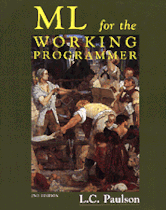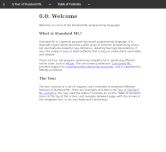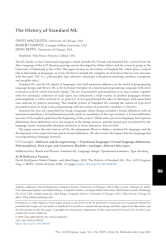Last Updated on May 22, 2022
ML (“Meta Language”) is a general-purpose functional programming language. It has roots in Lisp, and has been characterized as “Lisp with types”. ML is a statically-scoped functional programming language like Scheme.
It is known for its use of the polymorphic Hindley–Milner type system, which automatically assigns the types of most expressions without requiring explicit type annotations, and ensures type safety – there is a formal proof that a well-typed ML program does not cause runtime type errors.
Standard ML is a functional programming language with a formal specification. It has static types to prevent a wide array of common errors, but also features powerful type inference, requiring few to no type declarations. It is easy to define new data types and structures, due to algebraic data types, and write well-abstracted, easy to reason about code due to its powerful module system and parametric polymorphism (generics).
There are several languages in the ML family; the three most prominent are Standard ML (SML), OCaml and F#. We have written separate articles recommending the best free OCaml books and free F# books.
1. ML for the Working Programmer, 2nd Edition by Larry C. Paulson
 This book teaches the methods of functional programming – in particular, how to program in Standard ML. The author shows how to use such concepts as lists, trees, higher-order functions and infinite data structures and includes a chapter on formal reasoning about functional programming. This is meant to be a practical book.
This book teaches the methods of functional programming – in particular, how to program in Standard ML. The author shows how to use such concepts as lists, trees, higher-order functions and infinite data structures and includes a chapter on formal reasoning about functional programming. This is meant to be a practical book.
These include fast sorting functions and efficient function implementations of arrays, queues, and priority queues. Examples also include a ^D*l-calculus reducer and theorem prover. Most features of ML (including modules and imperative programming) are covered in depth and the book can be used without an ML reference manual.
The main features of the new Basis Library for the revised version of ML are described, and many new examples are given, e.g. polynomial arithmetic and new ways of treating priority queues.
The reader is assumed to have some experience in programming in conventional languages such as C or Pascal. For such individuals, be they students, graduates or researchers, this will be a useful introduction to functional programming.
2. A Tour of Standard ML by Alex Alegre
 The tour consists of a set of chapters, each intended to showcase different features of Standard ML.
The tour consists of a set of chapters, each intended to showcase different features of Standard ML.
For each section, there’s a concise example illustrating the material.
A Tour of Standard ML is built using Hakyll, a Haskell library for generating static sites.
This tour is published under the MIT License.
3. The History of Standard ML by David MacQueen, Robert Harper, and John Reppy
 This paper focuses on the history of Standard ML, which plays a central role in the ML family of strict functional languages, as it was the first to include the complete set of features that we now associate with the name “ML” (i.e., polymorphic type inference, datatypes with pattern matching, modules, exceptions,and mutable state).
This paper focuses on the history of Standard ML, which plays a central role in the ML family of strict functional languages, as it was the first to include the complete set of features that we now associate with the name “ML” (i.e., polymorphic type inference, datatypes with pattern matching, modules, exceptions,and mutable state).
The paper covers the early history of ML, the subsequent efforts to define a standard ML language, and the development of its major features and its formal definition.
The authors also review the impact that the language had on programming-language research.
Next page: Page 2 – The Standard ML Basis Library and more books
Pages in this article:
Page 1 – ML for the Working Programmer and more books
Page 2 – The Standard ML Basis Library and more books
All books in this series:
| Free Programming Books | |
|---|---|
| Ada | ALGOL-like programming language, extended from Pascal and other languages |
| Agda | Dependently typed functional language based on intuitionistic Type Theory |
| Arduino | Inexpensive, flexible, open source microcontroller platform |
| Assembly | As close to writing machine code without writing in pure hexadecimal |
| Awk | Versatile language designed for pattern scanning and processing language |
| Bash | Shell and command language; popular both as a shell and a scripting language |
| BASIC | Beginner’s All-purpose Symbolic Instruction Code |
| C | General-purpose, procedural, portable, high-level language |
| C++ | General-purpose, portable, free-form, multi-paradigm language |
| C# | Combines the power and flexibility of C++ with the simplicity of Visual Basic |
| Clojure | Dialect of the Lisp programming language |
| ClojureScript | Compiler for Clojure that targets JavaScript |
| COBOL | Common Business-Oriented Language |
| CoffeeScript | Transcompiles into JavaScript inspired by Ruby, Python and Haskell |
| Coq | Dependently typed language similar to Agda, Idris, F* and others |
| Crystal | General-purpose, concurrent, multi-paradigm, object-oriented language |
| CSS | CSS (Cascading Style Sheets) specifies a web page’s appearance |
| D | General-purpose systems programming language with a C-like syntax |
| Dart | Client-optimized language for fast apps on multiple platforms |
| Dylan | Multi-paradigm language supporting functional and object-oriented coding |
| ECMAScript | Best known as the language embedded in web browsers |
| Eiffel | Object-oriented language designed by Bertrand Meyer |
| Elixir | Relatively new functional language running on the Erlang virtual machine |
| Erlang | General-purpose, concurrent, declarative, functional language |
| F# | Uses functional, imperative, and object-oriented programming methods |
| Factor | Dynamic stack-based programming language |
| Forth | Imperative stack-based programming language |
| Fortran | The first high-level language, using the first compiler |
| Go | Compiled, statically typed programming language |
| Groovy | Powerful, optionally typed and dynamic language |
| Haskell | Standardized, general-purpose, polymorphically, statically typed language |
| HTML | HyperText Markup Language |
| Icon | Wide variety of features for processing and presenting symbolic data |
| J | Array programming language based primarily on APL |
| Java | General-purpose, concurrent, class-based, object-oriented, high-level language |
| JavaScript | Interpreted, prototype-based, scripting language |
| Julia | High-level, high-performance language for technical computing |
| Kotlin | More modern version of Java |
| LabVIEW | Designed to enable domain experts to build power systems quickly |
| LaTeX | Professional document preparation system and document markup language |
| Lisp | Unique features - excellent to study programming constructs |
| Logo | Dialect of Lisp that features interactivity, modularity, extensibility |
| Lua | Designed as an embeddable scripting language |
| Markdown | Plain text formatting syntax designed to be easy-to-read and easy-to-write |
| Objective-C | Object-oriented language that adds Smalltalk-style messaging to C |
| OCaml | The main implementation of the Caml language |
| Pascal | Imperative and procedural language designed in the late 1960s |
| Perl | High-level, general-purpose, interpreted, scripting, dynamic language |
| PHP | PHP has been at the helm of the web for many years |
| PostScript | Interpreted, stack-based and Turing complete language |
| Prolog | A general purpose, declarative, logic programming language |
| PureScript | Small strongly, statically typed language compiling to JavaScript |
| Python | General-purpose, structured, powerful language |
| QML | Hierarchical declarative language for user interface layout - JSON-like syntax |
| R | De facto standard among statisticians and data analysts |
| Racket | General-purpose, object-oriented, multi-paradigm, functional language |
| Raku | Member of the Perl family of programming languages |
| Ruby | General purpose, scripting, structured, flexible, fully object-oriented language |
| Rust | Ideal for systems, embedded, and other performance critical code |
| Scala | Modern, object-functional, multi-paradigm, Java-based language |
| Scheme | A general-purpose, functional language descended from Lisp and Algol |
| Scratch | Visual programming language designed for 8-16 year-old children |
| SQL | Access and manipulate data held in a relational database management system |
| Standard ML | General-purpose functional language characterized as "Lisp with types" |
| Swift | Powerful and intuitive general-purpose programming language |
| Tcl | Dynamic language based on concepts of Lisp, C, and Unix shells |
| TeX | Markup and programming language - create professional quality typeset text |
| TypeScript | Strict syntactical superset of JavaScript adding optional static typing |
| Vala | Object-oriented language, syntactically similar to C# |
| VHDL | Hardware description language used in electronic design automation |
| VimL | Powerful scripting language of the Vim editor |
| XML | Rules for defining semantic tags describing structure ad meaning |
